
展覽地點
香港中環龍和道9號 中環海濱(A15)
VIP預展
2019年3月26日 14:00-21:00
公眾日
2019年3月27日 11:00-17:00
2019年3月28日 至29日 12:00-21:00
2019年3月30日 11:00-19:00
2019年3月31日 11:00-17:00
Venue
Central Harbourfront Event Space,
9 Lung Wo Road, Central, Hong Kong
Booth No.A15
VIP Preview Day
14:00-21:00 on March 26th,2019
Public View Days
11:00-17:00 on March 27th , 2019
12:00-21:00 on March 28-29th, 2019
11:00-19:00 on March 30th , 2019
11:00-17:00 on March 31st , 2019
北京龍吟雅風視覺藝術中心
LYYF Visual Art Center
lyyf2015@163.com
作品闡述
Artworks Elaboration
唐華偉的繪畫,是用抽象方式表達自身的生命體驗、理性思考以及內心深處激蕩的情感。他的作品,線條動感,飽含能量;色彩感性甚或性感,厚如浮雕;畫面質地宛若鮮活的肌體蘊藏著春天般的生機。同時,他獨特的繪畫語言來自於他將中國書法的文化傳統創造性地融入到以西方文化為背景的油畫語言中,使粘稠的油彩在畫布上自由生成具有東方意味的視覺圖像,是藝術家在西方文化的理性架構上的具有東方精神的感性表達,用另一種方式詮釋書寫性視覺語言的當代意義。對當代藝術而言,他的探索,或許又像春天一樣,預示著新的開始。
In his paintings, Tang Huawei tries to express his life experience, rational thinking as well as feelings from deep heart by means of abstractness. In Tang’s works, these dynamic lines are full of vigor and energy, the emotional or erotic colors are thick and heavy just as emboss, aesthetic quality are vivid shown in his paintings, all of which revitalize vibrant lives as spring. Meanwhile, as his unique painting language, Tang puts the cultural tradition of Chinese calligraphy creatively into some visual language under the background of western civilization and then makes these sticky and heavy oil into some visual images with eastern meaning freely on canvas. Such an individual formal language expresses Tang’s feelings with oriental spirit on the framework of western rational culture and his explanation towards contemporary meaning of linear visual calligraphy in another way. For contemporary art, Tang’s practice probably predicts a new beginning just like spring.

《態(2018-12-22)》 布面油彩
State(2018-12-22) Oil on Canvas
150cm×120cm 2018
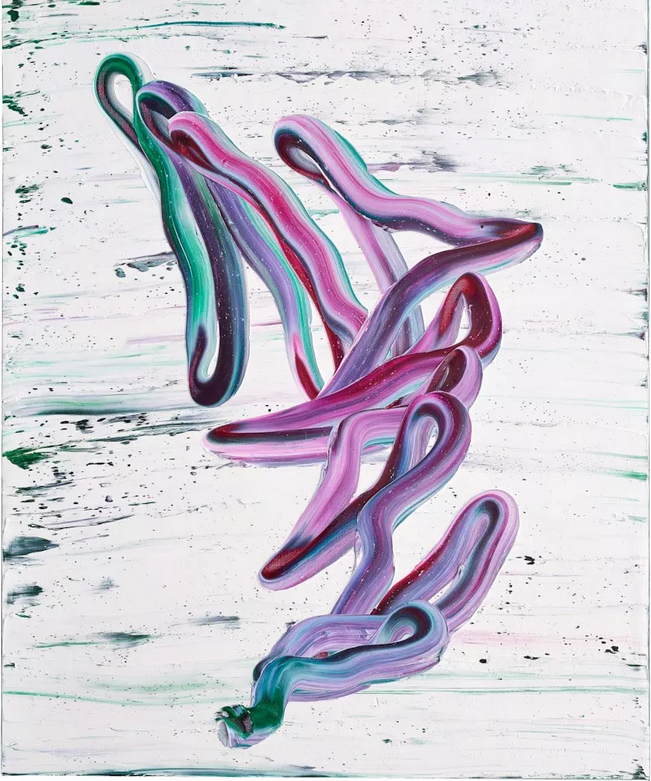
《態(2018-12-23)》 布面油彩
State(2018-12-23) Oil on Canvas
150cm×120cm 2018
藝評節選
Excerpts from Art Critics

《舞》 布面油彩
Dancing Oil on Canvas
150cm×100cm 2018
迪特·榮特(藝術批評家、策展人、德國波恩國家美術館前館長)
唐華偉的藝術並不是補充或延續已有的傳統圖像樣式,其本身就是一種圖像樣式的原創,它雖然是世界物體的延伸,但並非是對自然物象以及外部世界的直接描述。這些圖像講的是內心,情感,藝術性和自我中心的真理。
——摘自《唐華偉與線性抽象》
Dieter Ronte critic and curator former director of Kunstmeum Bonn, Germany
Tang Huawei’s art is not a supplement or extension towards existing traditional images, but an original of image style for art itself. It’s an extension of the world objects, but not an immediate description of natural objects or outward world. These images actually tells the truth of inner heart, emotion, art and egoism.
——Excerpt from Tang Huawei and His Linear Abstraction
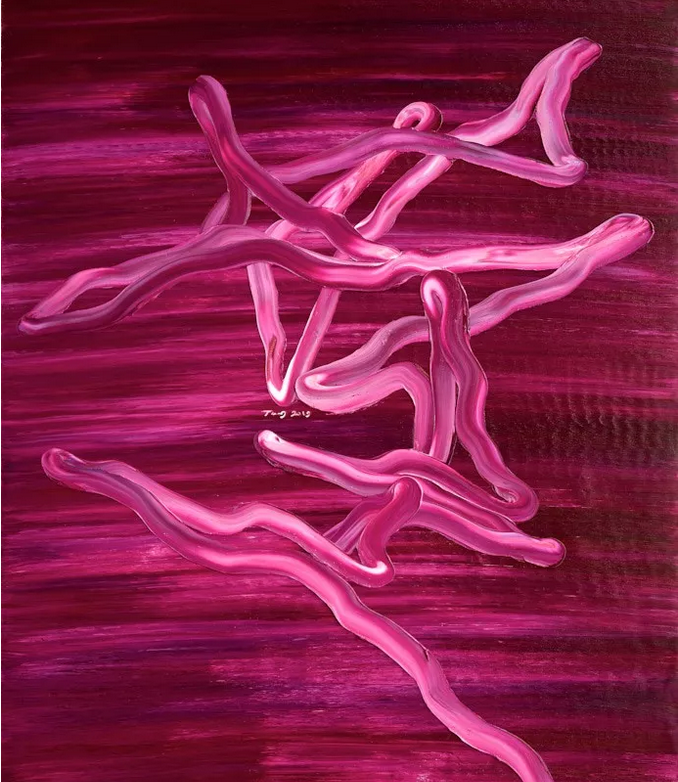
《中華史詩(2019-3-7)》 布面油彩
Chinese Epic(2019-3-7) Oil on Canvas
260cm×180cm 2019
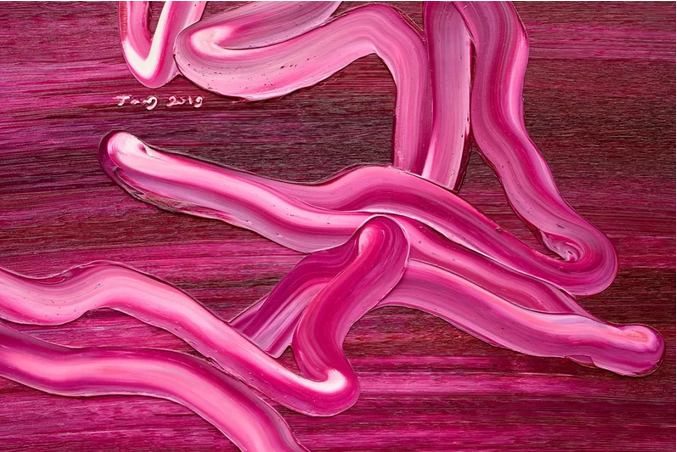
《中華史詩(2019-3-7)》 局部
Chinese Epic(2019-3-7) Part
顧振清(獨立策展人)
唐華偉油畫中的線條表現,追求的是重新啟動並轉換中國傳統書寫性文化範式的一種形式語言。全球化語境下,唐華偉仍一如既往地關注著精神生產的形式語言創新。他仍把繪畫視為當代的一種日趨異質化的個人精神生產方式。唐華偉並不諱言自身所受益的中西合璧的傳統精神資源,也慣常在中西方不同文明傳統的線索中探尋顛覆和創新的邏輯關係。然而,唐華偉當下更重視的是打造一種具有自身精神文化主體性的形式語言貢獻,並使之經得起中西方雙重文化語境的檢驗。為此,他潛心於觀想並體悟日常生活方方面面中的傳統審美淵源,同時執著於觀想並反思人性化的精神存在及其所傳承、蘊含的傳統基因和文脈。在唐華偉觀想、體悟、反思及其不斷循環往復的藝術實踐中,他的油畫語言形式日臻練達和圓融,顯示出一個活在當下的中國藝術家刷新自身精神存在的無限可能。
——摘自《精神的觀想:唐華偉的繪畫》
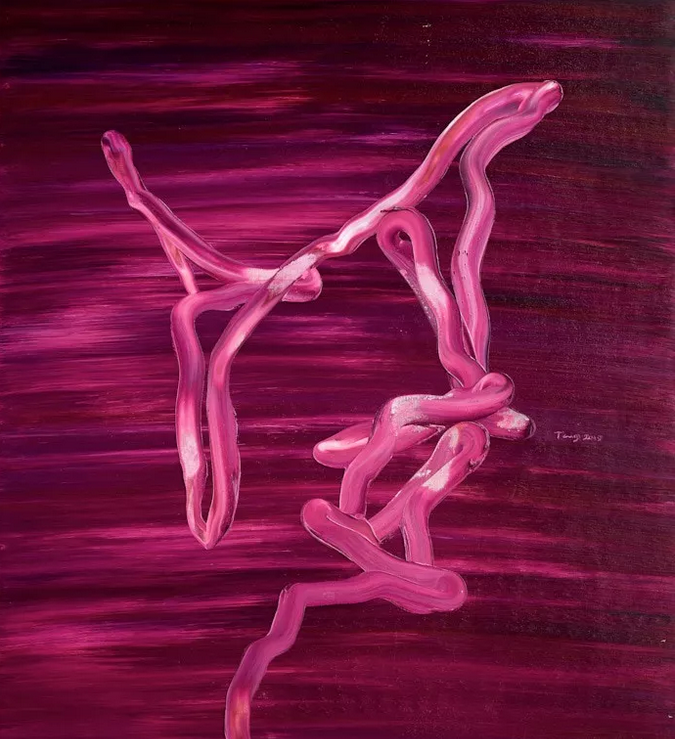
《孤鴻(2019-3-8)》 布面油彩
Lonely Swan Goose (2019-3-8) Oil on Canvas
260cm×180cm 2019
Gu Zhenqing independent curator
In the line expression, Tang Huawei seeks for the language of form to reinvigorate and transform traditional Chinese form of writing culture. In the globalized context, Tang always pays attention to the innovation of formal language of spiritual production, and considers painting as a contemporary production of individual spirit which tends to heterogenize. Tang never denied the traditional spiritual resource combining the east and the west which he benefits from, and always seeks to break through and innovate in logical relationship by eastern and western civilization tradition. However, Tang emphasizes more on creating a kind of formal language with its own subjective spiritual culture, and empowering it to stand right up to the test of the cultural context combining the east and the west. For this purpose, he has been observing and thinking over the origin of traditional aesthetics in daily life, as well as humanized spiritual existence, traditional gene and cultural origin it carried and contained. In his artistic practices filled with repeated observation, contemplation and reflection, Tang’s form of language became increasingly experienced and harmonious, showing the infinite possibility of the contemporary Chinese artist to refresh his/her own spiritual existence.
——Excerpt from Observation and Contemplation on Spirit: Tang Huawei’s Painting

《紫(2018-12-5)》 布面油彩
Purple(2018-12-5) Oil on Canvas
190cm×180cm 2018
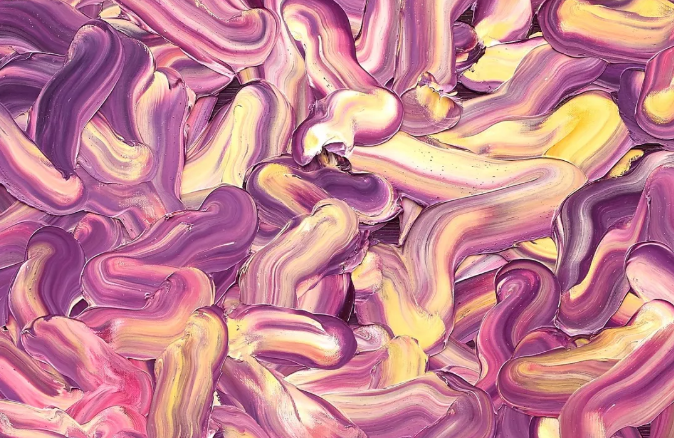
《紫(2018-12-5)》 局部
Purple(2018-12-5) Part
亞曆山德羅·里瓦(義大利米蘭美術學院美術史系教授、批評家)
他的繪畫語言是由一個個有靈性的、流動的、類似液體的符號組成,這些符號再加上不錯下一筆的連續性重複運動,構成了他新穎獨創、卓爾不群的藝術品格。正因為這樣,唐華偉作為遊走在抽象與具象之間的藝術家,也因此在當代藝術領域擁有了自己的一席之地。
——摘自《唐華偉:打破風景,尋找“點金之石”》
Alessandro Riva the professor and critic in the Department of Fine Art, Italy Milan Academy of Fine Arts
His painting language consists of a series of single, organic, fluid, and liquid signs, which are unmistakable in its flowing repetitiveness and becomes his distinctive artistic feature, original and perfectly recognizable. In that, the artist regains possession of the world as an abstract and material entity at the same time.
——Excerpt from Tang Huawei, the Disappearance of the Landscape and the Search for the Philosopher’s Stone
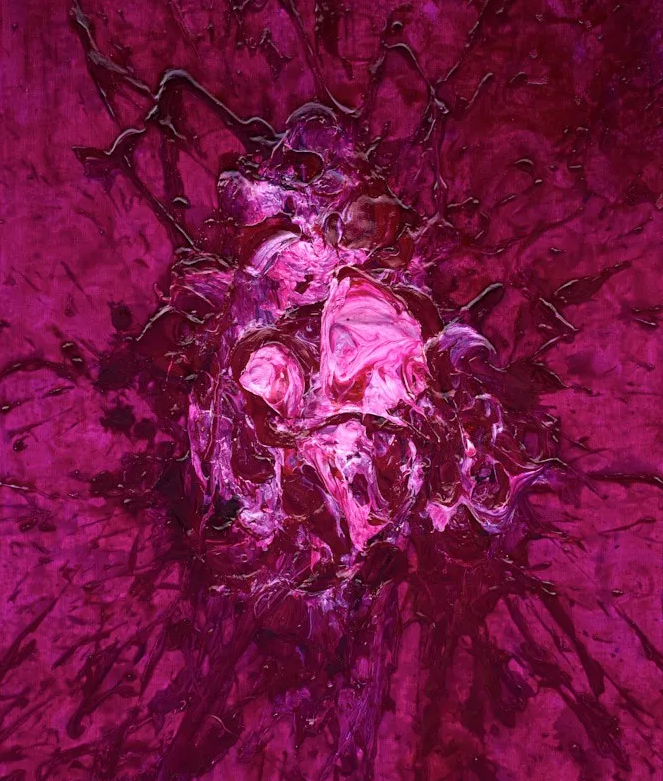
《肌理(2019-2-26)》 布面丙烯
Texture(2019-2-26) Acrylic on Canvas
150cm×100cm 2019
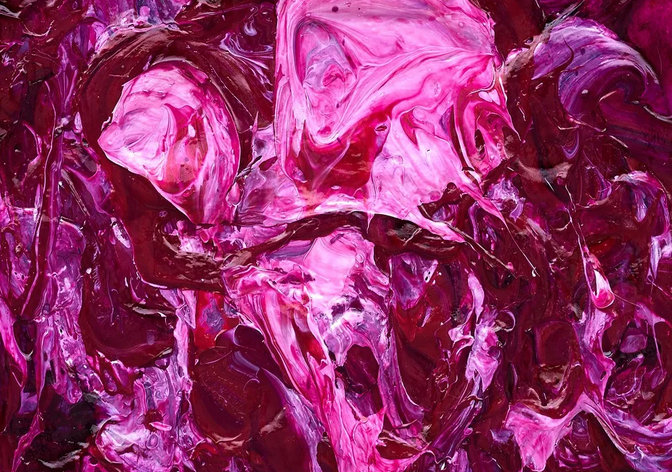
《肌理(2019-2-26)》 局部
Texture(2019-2-26) Part
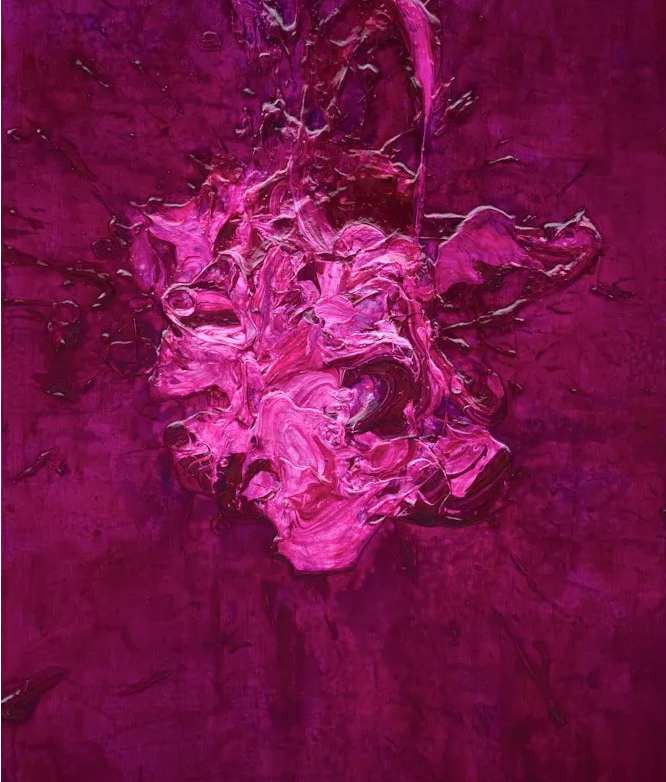
《肌理(2019-2-27)》 布面丙烯
Texture(2019-2-27) Acrylic on Canvas
150cm×100cm 2019
西爾維·薩瑪尼(法國作家、藝評家)
……(唐華偉)在選擇合適的方式去呈現生命的紛繁複雜之前,專注於精神的耕作,有意用單一的表現形式來表達他對精神純粹性的追求。他通過繪畫試圖極力找尋事物中更為深刻的核心,從而挖掘出關聯中被遺忘的本質。
——摘自《關聯》
Sylvie SAMANI a French writer and art critic
……(Tang Huawei) concentrates on spiritual cultivation, before selecting the adequate brush to render the intricacies of life, and the deliberate paucity of means shown in his tools speak for his spiritual pursuit. The artist sharpened his thoughts to search deeper more into the core of matter to retrieve the forgotten nature of relatedness.
——Excerpt from Relatedness
夏可君(哲學博士、策展人)
一個好的藝術家必須找到化解油畫顏料的方式,油畫顏料本身不過是一種已經僵化的工業化生產的材料,只有精神可以化解之,以視覺建構或者造型塑造是容易的,但只有通過個體的精神,以個體的血液來化解顏料,使之活躍起來,使之充滿靈性,才可能煥發出迷人的呼吸,這需要藝術家持久的琢磨顏料,甚至很多年孤獨而持久的工作,如同詩人裏爾克寫到塞尚所言的“孤獨而強大”,我們就看到中國藝術家唐華偉這麼多年來也是以其“寂寞而堅韌”的氣質,以自己獨特的藝術語言,喚醒了自然的靈性。
——摘自《唐華偉的新繪畫:書寫自然的精神肖像》
Xia Kejun the curator and PhD
A good artist must find a way to dissolve oil paints. No more than an already rigidified industrial material, oil paint can be dissolved with spirit. It may be easier to adopt visual construction or shape modeling, but only with individual’s spirit and blood, the paints can be reinvigorated and spiritualized, and thus enchanted with charming air. It requires artists to persistently study on paints, in years of lonely and relentless works. As the poet Rilke described Cezanne "lonely but strong", Chinese artist Tang Huawei has been "lonely and tenacious" for years, to awaken the soul of nature with his unique artistic language.
——Excerpt from Tang Huawei’s New Painting: Drawing the Spiritual Portrait of Nature
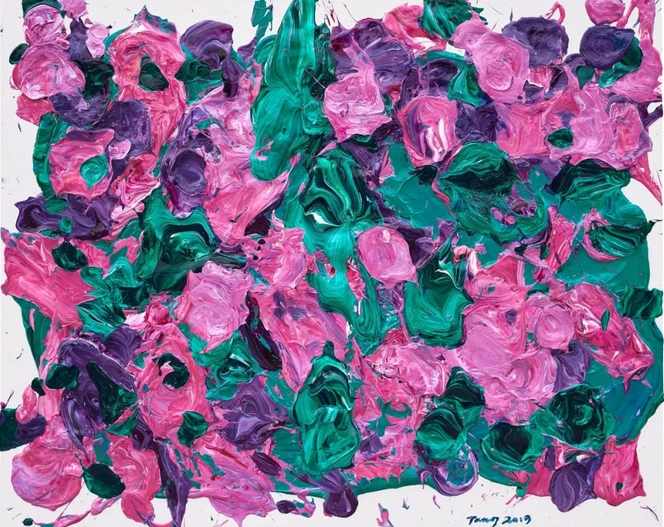
《迷(2019-2-12)》 布面丙烯
Fascinating(2019-2-12) Acrylic on Canvas
80cm×100cm 2019
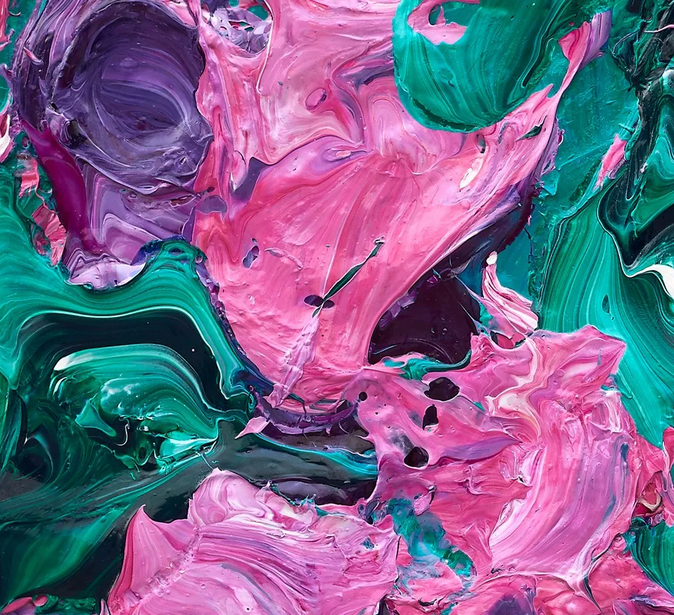
《迷(2019-2-12)》 局部
Fascinating(2019-2-12) Part

《感性體(2019-2-7)》 布面丙烯
Senseware(2019-2-7) Acrylic on Canvas
100cm×80cm 2019
貝婭特·海芬夏特(博士、策展人、德國科布倫茨路德維希博物館館長)
唐華偉發展出了極其抽象的畫法。動感的、濃稠的、看似雜亂無章的線條與背景融在一起,展開成一幅精巧的、像是在想像的空間上飛揚的圖像。其畫作的寬度與深度令觀者迅速沉浸其中。他的作品,由線團與類似波普藝術的濃烈色彩共同構成,展現了對於過去時代無法再次重現的、已然消失不見的天堂的反思。
——摘自《中國當代油畫》
Beate Reifenscheid PhD, curator and director of Ludiwig Museum in Koblenz, Germany
Tang Huawei develops some kind of extremely abstract painting technique. These lines, that are dynamic, dense, seemingly rambling, blend in with the background and a series of exquisite images that flying on a fancy space. The width and depth of the artworks make the viewers immerse in it rapidly. His works, which consist of ball of strings and strong colors just like Pop art, show the reflection towards the unrepeatable and disappearing paradise of the past.
——Excerpt from Chinese Contemporary Oil Painting
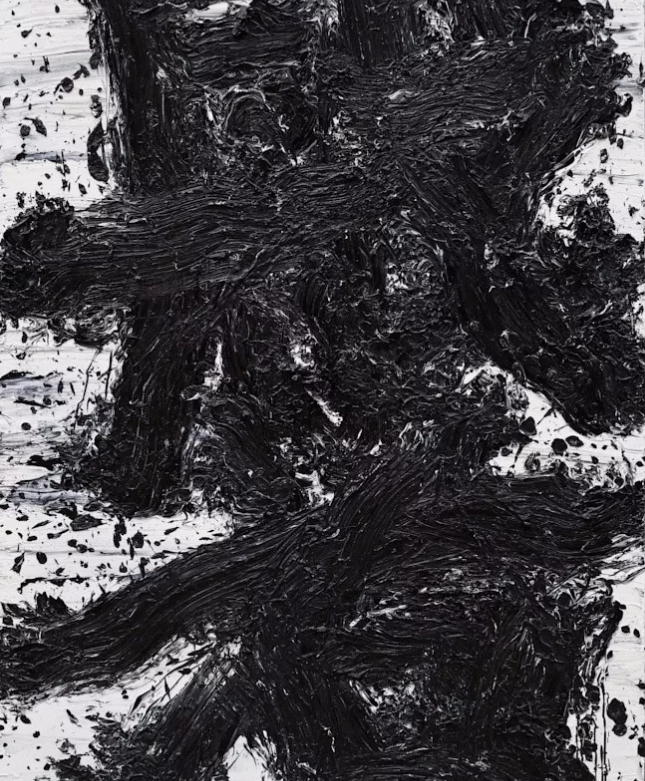
“漢字”系列《般若》 布面油彩
Chinese Character Series(般若) Acrylic on Canvas
180cm×120cm 2018
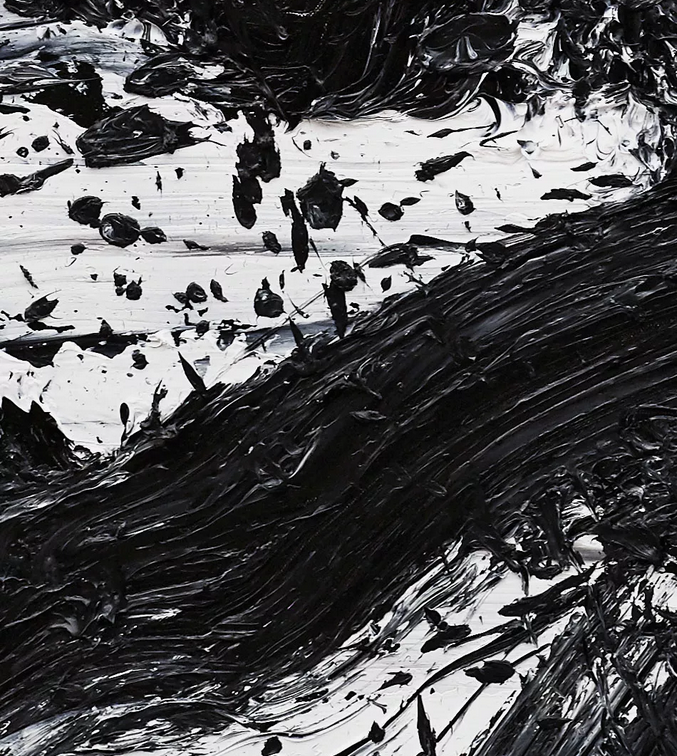
“漢字”系列《般若》 局部
Chinese Character Series(般若) Part
彥(博士、策展人、批評家)
唐華偉選擇的畫種是舶來品,而不是傳統水墨。但是,從他的自述中,從他的作品中,乃至從他行文的慣習中,卻分明透露出傳統的因數。這證明中國遠古傳統對這位年輕藝術家的創作產生了舉足輕重的作用。他常常從傳統的思維中觀察當下,又從當下的觀察反思傳統。這一雙向思維正是構成他的藝術實踐的奇妙基礎,讓他一直處在不無空靈的遊移狀態中,像基因四處漂浮那樣,尋找著變異的可能。
——摘自《心跡筆痕無我詩——讀唐華偉作品感懷》
Yang Xiaoyan the curator, critic and PhD
Tang Huawei selected an imported artistic form, instead of traditional ink and wash. But in his statement, in his works and even in his way of writing, obviously showed is the traditional element, which proves that Chinese tradition has been significantly influencing the young artist’s creation. He observes the current in the way of traditional thinking, and reflects on tradition with the observation of the current. The two-way thinking laid the foundation of his artistic practice, enabling him to stay in a floating state, as if he is the gene floating all around and looking for the possibility of variation.
——Excerpt from Poetry in Heart Without Ego—Reflections upon Tang Huawei’s Artworks
作者自述
Artist's Readme
藝術最吸引我的,是可以在未知中創造驚喜。
What attracts me by art is that I always acquire many pleasant surprise from unknown things.
——唐华伟 | Tang Huawei
我的線,雖然置於畫布與厚厚的油彩之上,但是其精神內涵來源於書法藝術,運行起來又與中國功夫的運動規則相似:“心與意合,意與氣合,氣與力合”。追求:藏頭護尾,棉裏裹鐵,力在其中;虛實相生,虛處有實,實處藏虛;首尾呼應,隨勢應變,一氣呵成。
These lines from my paintings lay over canvas and dense oil paint, but its spiritual connotation originates from calligraphy art and belongs to the motive rules similar to Chinese kung fu when running on canvas, all is identical that mind is woven with heart; pneuma and mind work in balance; energy accords with penuma. I pursue the aesthetic principles, that is, there is strength as well as grace in the forcible and vigorous stroke of penmanship; there is false and true complement: reality is hidden virtual and vice versa; there is echo of fore and aft, expecting and reacting to change and remarkably smooth.
——唐华伟 | Tang Huawei
作者簡介
Artist's Introduction

唐華偉,生於1972年,中國當代藝術家,先後就讀於中央美術學院、中國藝術研究院研究生院,工作、生活於北京。作品涉及繪畫、裝置、影像。受邀擔任多個研究性展覽與專業出版物的學術主持。作品進入國內外多個美術館及公共藝術機構。其沉潛十數年,苦心孤詣,創立了完整的繪畫語言與理論體系,被藝評家譽為“寂寞而堅韌的修道者”。
Tang Huawei, a Chinese contemporary artist, was born in 1972. Once studied in China Central Academy of Fine Arts and the Graduate School of Chinese National Academy of Arts. Now he lives and works in Beijing as a professional artist. His works involve in paintings, installations and images. Tang has been invited to serve as the academic host of many research exhibitions and professional publications. His works have entered many art museums and public art institutions both at home and abroad. He devoted over 10 years to studying oil painting, artistic practice and in-depth contemplation,and finally reconstructed his unique painting language and theoretic system, fulfilled his transition from traditional to contemporary artist, thus called as a “tough but lonely” ascetic by critics.
